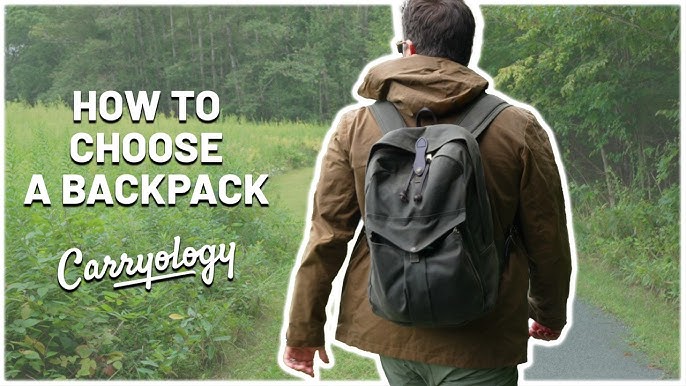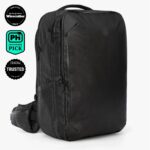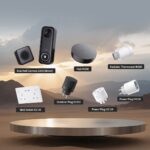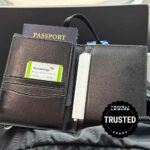Choosing the right backpack can change the way you carry your essentials every day. Whether you need it for school, work, travel, or outdoor adventures, the perfect backpack makes your life easier and more comfortable.
But with so many options out there, how do you find the one that fits your needs perfectly? You’ll discover simple tips to pick a backpack that suits your style, supports your body, and keeps your belongings safe. Keep reading—you’re about to make a decision that will make every trip better.

Backpack Types
Choosing the right backpack starts with understanding the types available. Different backpacks serve different purposes. Each design offers unique features for specific activities.
Knowing the main backpack types helps pick one that fits your needs. Here are the common types to consider.
Daypacks
Daypacks are small and lightweight. They hold essentials for daily use or short trips. Ideal for school, city walks, or light hiking. They usually have one main compartment and a few pockets. Comfortable straps make them easy to carry all day.
Hiking Backpacks
Hiking backpacks are built for outdoor adventures. They offer more space and support for longer trips. These backpacks have padded straps and hip belts to spread weight. Many come with hydration pack sleeves and multiple compartments. Durable materials protect against rough conditions.
Travel Backpacks
Travel backpacks focus on convenience and security. They often open like a suitcase for easy packing. Multiple compartments help organize clothes and gear. Lockable zippers keep belongings safe. Comfortable straps and back panels make long walks easier.
Laptop Backpacks
Laptop backpacks protect electronics with padded compartments. They have extra pockets for chargers, documents, and accessories. These backpacks suit students and professionals. Stylish designs fit offices or classrooms. Lightweight materials keep the load manageable.

Size And Capacity
Choosing the right size and capacity is key to finding a good backpack. It affects comfort and how much you can carry. A backpack too small will not hold all your items. One too large may feel heavy and bulky.
Understanding size and capacity helps pick the best fit for your activities. Different uses need different amounts of space. Knowing what volume means and matching it to your needs saves time and effort.
Volume Measurements
Backpack size is often shown as volume in liters. This number tells how much space is inside. A small backpack may be around 15 to 25 liters. Medium ones range from 25 to 40 liters. Large backpacks can hold 50 liters or more.
Volume helps compare backpacks by their total carrying space. Some brands list the main compartment size only. Others include all pockets and sections. Check the details to know exactly how much room is available.
Matching Capacity To Needs
Think about what you will carry most. For daily use, a 15 to 25-liter backpack works well. It fits essentials like books, lunch, and a jacket. For day hikes, choose 25 to 35 liters. This space fits water, snacks, and extra clothes.
Overnight trips need bigger backpacks, around 40 to 60 liters. They hold sleeping bags, cooking gear, and more clothes. For long journeys or heavy gear, backpacks over 60 liters are best.
Picking the right size avoids carrying too much weight. It also keeps your back comfortable and balanced.
Fit And Adjustability
Choosing a backpack that fits well makes a big difference in comfort. A good fit stops pain and strain during long use. Adjustability helps the backpack match your body shape perfectly. This section focuses on three key areas: torso length, hip belt position, and shoulder straps. Each part plays a role in how the backpack feels and supports you.
Torso Length
Your torso length is the distance from your neck base to your waist. A backpack should match this length closely. Too long or too short causes discomfort and poor weight distribution. Many backpacks offer adjustable torso lengths. Measure your torso before buying. This step ensures the pack sits right on your back.
Hip Belt Position
The hip belt carries most of the backpack’s weight. It should rest on your hip bones, not your waist. A well-positioned hip belt reduces pressure on your shoulders. Check if the belt adjusts up or down. This allows you to place it right where it supports best. A snug fit here feels lighter on your back.
Shoulder Straps
Shoulder straps keep the backpack close to your body. They should be padded but not too tight. Adjust the straps so the pack sits comfortably without pulling. Straps that dig into your shoulders cause pain and fatigue. Look for straps that contour to your shoulders. This shape helps spread the weight evenly.
Comfort Features
Choosing a backpack with good comfort features makes a big difference. A comfortable backpack helps avoid pain and strain during use. It lets you carry your stuff easily for a long time. Focus on key comfort features to get the best fit.
Padding And Ventilation
Padded shoulder straps cushion your shoulders from heavy weight. Look for thick, soft padding that feels good on your skin. Back padding is just as important. It protects your back and adds support. Ventilation channels in the padding help air flow. This keeps your back cool and dry.
Weight Distribution
Good weight distribution stops pressure points and back pain. A backpack that spreads weight evenly feels lighter. Hip belts take load off your shoulders and put it on hips. This helps when carrying heavy or bulky items. Adjustable straps let you change the fit. A better fit means better balance and less fatigue.
Load Lifters
Load lifters are small straps near the top of shoulder straps. They pull the backpack closer to your body. This keeps the weight near your center of gravity. It stops the pack from pulling you backwards. Load lifters improve balance and reduce shoulder strain. Check for easy-to-use and strong load lifters.
Material And Durability
Choosing the right material affects a backpack’s durability and comfort. Strong materials last longer and protect your belongings better. Understanding fabric types, water resistance, and reinforcements helps pick the best backpack for your needs.
Fabric Types
Backpacks use different fabrics like nylon, polyester, and canvas. Nylon is light and strong. Polyester resists wrinkles and holds color well. Canvas is thick and tough but heavier. Each fabric suits different activities and weather conditions.
Water Resistance
Water-resistant materials keep your items dry in light rain. Some fabrics have coatings to stop water from soaking in. Fully waterproof backpacks protect belongings in heavy rain but may cost more. Consider your usual weather before choosing.
Reinforcements
Reinforcements add strength to weak spots like corners and straps. Look for extra stitching or patches on these areas. Reinforced backpacks handle heavy loads better and last longer. This feature is important for daily use or hiking trips.

Organizational Elements
Organizational elements in a backpack help keep your items tidy and easy to find. They make carrying things more efficient and stress-free. Choosing a backpack with smart organization can save time and hassle during your day.
Compartments And Pockets
Compartments divide the backpack into sections for different items. Pockets provide extra space for small things like keys or phones. Multiple compartments keep your belongings separate and protected. They help prevent items from getting lost or damaged.
External Attachment Points
External attachment points let you carry gear outside the backpack. These can include loops, straps, or daisy chains. They are useful for hiking gear, water bottles, or helmets. Attachment points add extra carrying options without crowding the inside.
Hydration Compatibility
Hydration compatibility means the backpack fits a water bladder or bottle. A hydration sleeve inside holds the bladder securely. A hose outlet allows easy drinking without removing the pack. This feature keeps you hydrated on long walks or hikes.
Style And Design
Choosing a backpack is not just about function. Style and design make a big difference. Your backpack should reflect your personality and fit your daily needs. It should feel right and look good on you. Let’s explore some key points about style and design to help you pick the best one.
Color Options
Color is an easy way to show style. Some like bright colors to stand out. Others prefer neutral shades for a classic look. Dark colors hide dirt better, which is great for travel or work. Light colors can look fresh but need more care. Choose a color that matches your wardrobe and lifestyle.
Minimalist Vs. Feature-rich
Minimalist backpacks have clean lines and few pockets. They suit those who carry only essentials. Feature-rich backpacks come with many compartments and extras. They help organize gadgets, books, and accessories. Think about what you carry daily. Pick a style that makes your life easier.
Brand Preferences
Some people trust specific brands for quality and style. Popular brands offer tested designs and good materials. New brands might bring fresh ideas and unique looks. Brand loyalty can guide your choice but try to compare. Find a backpack that feels right and lasts long.
Budget Considerations
Choosing a backpack often depends on your budget. Knowing how much to spend helps narrow down options. Budget matters because backpacks vary a lot in price and quality. It is important to find the right balance between cost and features. This section helps you understand price ranges and how to get the best value.
Price Ranges
Backpacks come in many price ranges. You can find basic models under $30. These are good for light use or short trips. Mid-range backpacks cost between $50 and $100. They offer better materials and more features. High-end backpacks cost over $100. These have strong fabrics, extra padding, and more compartments. Decide what price fits your needs and how often you will use the bag.
Balancing Cost And Quality
Cheap backpacks may not last long. They can tear or lose shape quickly. Expensive backpacks are usually more durable and comfortable. Look for backpacks with good stitching and strong zippers. Check for padded straps and back support. A backpack that lasts saves money in the long run. Choose a backpack that meets your needs without spending too much.
Trying It On
Trying on a backpack is a key step before buying. It helps you see if the bag fits well and feels comfortable. A backpack that fits right supports your back and shoulders. It also makes carrying heavy loads easier. Follow these steps to test the backpack properly.
Load Testing
Put some weight inside the backpack. Use items similar to what you will carry daily. This could be books, clothes, or a laptop. Check how the backpack holds the weight. Does it feel balanced? The bag should not pull you backward or sideways. This shows good weight distribution.
Adjusting Straps
Adjust all straps to fit your body. Tighten the shoulder straps so the bag sits close to your back. Use the hip belt to move weight to your hips. Adjust the chest strap to keep the bag stable. Straps should feel snug but not too tight. Proper adjustment improves comfort and support.
Walking And Moving
Walk around with the loaded backpack on. Move your arms and bend down to test freedom of movement. The bag should stay in place and not bounce. Check for any pressure points or discomfort. A good backpack moves with you and feels natural.
Frequently Asked Questions
What Size Backpack Is Best For Everyday Use?
A 20 to 30-liter backpack fits daily needs like books, gadgets, and snacks comfortably.
How To Choose A Backpack For Hiking Trips?
Pick a backpack with padded straps, good back support, and water resistance for hiking.
Which Materials Make Backpacks More Durable?
Look for backpacks made of nylon or polyester for strength and water resistance.
How Important Is Backpack Weight For Comfort?
Lighter backpacks reduce strain, making them easier and more comfortable to carry longer.
What Features Help Organize Items In A Backpack?
Multiple compartments, pockets, and dividers keep your items neat and easy to find.
Conclusion
Choosing the right backpack makes daily life easier and more comfortable. Think about size, comfort, and what you need to carry. Try on different styles to find the best fit. Quality materials help your backpack last longer. A good backpack supports your back and shoulders well.
Remember, the best backpack matches your lifestyle and needs. Take your time and choose wisely. Your perfect backpack is out there waiting. Ready to carry your world with ease?






